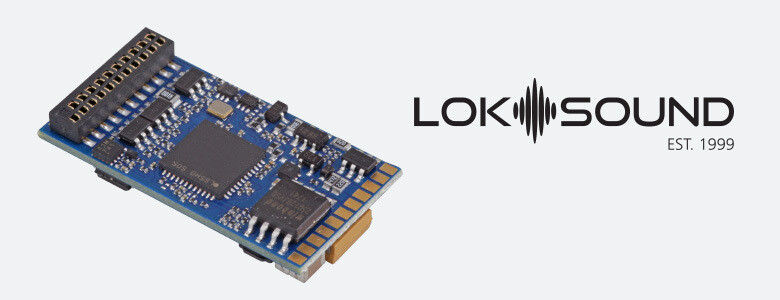ESU LokSound 5 DCC 8-Pin
Please note LokSound Decoders come blank with no soundfile out of the box. The LokProgrammer allows you to write soundfiles to your decoders and modify decoder settings in a user-friendly interface without the need to memorize or calculate CVs. In case you don't yet own the LokProgrammer, we offer our customers a free soundfile loading service for any LokSound decoder purchased from our shop. We will load the appropriate to your decoder(s) that will include multiple horns, bells air dryers, and other sounds that can be selected with standard CV programming on your DCC system. When checking out, make a note of what locomotive you're installing the decoder in.
For example:
"BNSF 9782 SD70Mac" or "UP 844 GP30"
Alternatively, you can browes ESU's extensive North American sound library at the following link to hear sound samples, and makea note at checkout of your desired soundfile number. (We can also swap horn and bell packs per request).
https://projects.esu.eu/projectoverviews/18
For example:
"S0720" or "S0758 with 2nd generation horn pack 8"
Links to British and European soundfiles can be found at the main projects page here: https://projects.esu.eu/
Please be sure to specifiy which sounds go on which decoder if purchasing multiple decoder models.
The LokSound 5 is the most important member of the LokSound family. Due to the combination of the digital decoder and the sound module on one circuit board we achieve the smallest possible dimensions of 30 mm x 15.5 mm. Therefore it fits into almost any H0 or 0 gauge locomotive.
LokSound 5 decoders are available with all popular interface types and are supplied with a sugar cube speaker (11 mm x 15 mm) and a sound enclosure.
The LokSound 5 DCC is made for the North American and Australian markets. It is a pure DCC Decoder, which supports RailComPlus and can also be used on DC layouts. Please note the LokSound 5 DCC decoder does not come with a speaker.
Operating modes
Like all products of the LokSound family the LokSound 5 is a true multi protocol decoder. It supports DCC as well as Motorola®, Selectrix® and M4. Of course it supports 14 through to 128 speed steps as well as 2 and 4 digit addresses in DCC format and up to 32 functions. Thanks to RailComPlus® the decoders register themselves fully automatically on suitable command stations.
This decoder supports all DCC programming modes and thanks to RailCom® you may read out the CV values on the main, provided you have a command station supporting RailCom®. There are utility registers for command stations that only facilitate programming of CVs ranging from 1 to 255.
Motorola® users benefit from up to 28 speed steps for 255 addresses. Three additional Motorola® addresses facilitate triggering of 16 functions. An integral programming mode even allows programming with the good old Central Unit 6021.
The M4 protocol supports the automatic registration on mfx® compatible central units.
The LokSound 5 decoder supports the Märklin® braking sections just as well as the ZIMO® HLU braking commands or the Lenz® ABC system. Braking with DCC brake generators or with DC is also possible. Furthermore the locomotive with a LokSound will come to a halt when a Selectrix® braking diode is switched into the circuit. The ABC push-pull feature enables the automatic commuting between two stations.
The LokSound 5 decoder is also suitable for analogue DC and AC (!) layouts.
Sound
The LokSound 5 decoder can reproduce up to 10 channels simultaneously. Each channel offers up to 16 Bit / 31250 kHz and thus we have finally achieved hi-fi sound quality on your layout. For all practical purposes one cannot detect any difference to the original. A class D audio power amplifier with up to 3W output power feeds the speakers with a permitted impedance of 4 – 32 Ohms. The huge 128 MBit sound memory assures sufficient storage capacity.
The volume of all individual sound fragments may be adjusted separately. The outstandingly flexible sound engine without a rigid flow chart facilitates a prototypical simulation of all conceivable rail vehicles. Three separately adjustable braking functions and two alternative load scenarios provide you with maximum control of your vehicles.
Functions
We are quite aware that you want your locomotives to be as realistic as possible. Therefore we have packed many function outputs into it. Subject to the type of interface every LokSound 5 has at least 10 amplified outputs. The decoders with PluX22 or 21MTC interface have an additional 4 outputs for controlling servos or as logic outputs. Of course, all important lighting functions are supported. The brightness of each output may be adjusted separately. The decoder supports the automatic push and pull movements – known as the coupler waltz - required for reliable operation of digital couplers such as the ones by ROCO® and Krois® as well as Telex® couplers.
Motor control
Motor control of the LokSound 5 has been further improved. A variable PWM pulse frequency ranging from 10 kHz to 50 kHz assures perfect silent operation, particularly for coreless motors. Thus the typical hum is a thing of the past. Load control can now be adjusted with up to 10 separate CVs and thus will manage even the most difficult cases. The unique “Auto Tune” function facilitates the automatic calibration of the decoder to perfectly match the motor. The LokSound 5 decoder supplies up to 1.5A motor current, which is quite sufficient even for older motor types.
LokSound 5 DCC
The LokSound 5 DCC is made for the North American and Australian markets. It is a pure DCC Decoder, which supports RailComPlus and can also be used on DC layouts.
